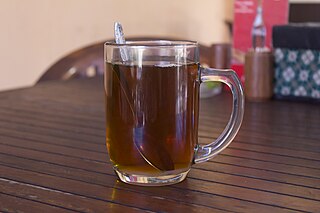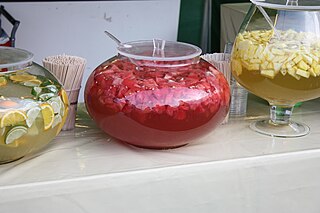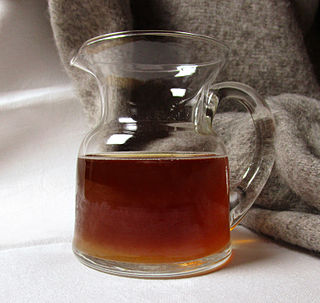
A drink or beverage is a liquid intended for human consumption. In addition to their basic function of satisfying thirst, drinks play important roles in human culture. Common types of drinks include plain drinking water, milk, juice, smoothies and soft drinks. Traditionally warm beverages include coffee, tea, and hot chocolate. Caffeinated drinks that contain the stimulant caffeine have a long history.

Mead, also called honey wine, and hydromel, is an alcoholic beverage made by fermenting honey mixed with water, and sometimes with added ingredients such as fruits, spices, grains, or hops. The alcoholic content ranges from about 3.5% ABV to more than 20%. Possibly the most ancient alcoholic drink, the defining characteristic of mead is that the majority of the beverage's fermentable sugar is derived from honey. It may be still, carbonated, or naturally sparkling, and despite a common misconception that mead is exclusively sweet, it can also be dry or semi-sweet.

Mulled wine, also known as spiced wine, is an alcoholic drink usually made with red wine, along with various mulling spices and sometimes raisins, served hot or warm. It is a traditional drink during winter, especially around Christmas. It is usually served at Christmas markets in Europe, primarily in Germany, Czech Republic, Austria, Switzerland, Slovenia, Croatia, Hungary, Romania, Nordics, Baltics and eastern France. There are non-alcoholic versions of it. Vodka-spiked mulled wine can be found in Polish Christmas markets, where mulled wine is commonly used as a mixer.

Akvavit or aquavit is a distilled spirit that is principally produced in Scandinavia, where it has been produced since the 15th century. Akvavit is distilled from grain or potatoes and is flavoured with a variety of herbs. It is also popular in Northern Germany.

Carlsberg A/S is a Danish multinational brewer. Founded in 1847 by J. C. Jacobsen, the company's headquarters is in Copenhagen, Denmark. Since Jacobsen's death in 1887, the majority owner of the company has been the Carlsberg Foundation. The company's flagship brand is Carlsberg. The company employs around 41,000 people, primarily in Europe and Asia. Carlsberg is currently the 6th largest brewery in the world based on revenue.

The term punch refers to a wide assortment of drinks, both non-alcoholic and alcoholic, generally containing fruits or fruit juice. The drink was introduced from the Indian subcontinent to England by employees of the East India Company in the late 17th century. Punch is usually served at parties in large, wide bowls, known as punch bowls.
Scottish & Newcastle plc was a brewing company headquartered in Edinburgh, Scotland, which expanded from its home base to become an international business with beer volumes growing almost tenfold.

Louis Roederer is a producer of champagne based in Reims, France. Founded in 1776, the business was inherited and renamed by Louis Roederer in 1833. It remains as one of the few independent and family-run maisons de champagne. Over 3.5 million bottles of Louis Roederer champagne are shipped each year to more than 100 countries.
Several brands of beer are produced and served in Romania, including beer from local breweries and craft beers. The history of this beverage includes the territory of the Romanian lands, since at least the times of the Romanian Old Kingdom to contemporary times.
Beer is a popular alcoholic beverage in Turkey, mostly lager type beers.

A. Le Coq is an Estonian brewery. The company was founded in 1807 by a Prussian family of the same name, who were descendants of the Huguenots who had fled France in the 17th century. The company was bought in 1997 and is currently owned by the Finnish company Olvi. It produces many types of drinks including beers, long drinks, ciders and soft drinks. The best known beer is the A. Le Coq Premium, which is the most popular beer in Estonia, according to the latest AC Nielsen results in October 2008. A. Le Coq Arena in Tallinn was named after the beer.

Hartwall Ltd is a beverage company based in Helsinki, Finland. It was founded in 1836. Its drinks range includes Jaffa, Pommac and Novelle waters. The company also owns the licence for manufacturing and selling PepsiCo's Pepsi, 7 Up and Mountain Dew brands in Finland. Hartwall's alcoholic beverages include Upcider cider, Lapin Kulta lager beer, Karjala beer and is the local producer of Foster's lager. In 2002, Hartwall was purchased by the UK based Scottish & Newcastle corporation, and when that company was bought out in 2008 the brand became owned by Heineken. Danish Royal Unibrew bought Hartwall in 2013. In 2017, a special beer brewery was completed in connection with the Lahti brewery, which was named Mattsson after a local beer influencer. In May 2019 Hartwall opened a Brewery Shop in their factory in Lahti, Kasaajankatu 13.

A Bellini is a cocktail made with Prosecco and peach purée or nectar. It originated in Venice, Italy.
Azerbaijani cuisine is the cooking styles and dishes of the Republic of Azerbaijan. The cuisine is influenced by the country's diversity of agriculture, from abundant grasslands which historically allowed for a culture of pastoralism to develop, as well as to the unique geographical location of the country, which is situated on the crossroads of Europe and Asia with access to the Caspian Sea. The location has enabled the people to develop a varied diet rich in produce, milk products, and meat, including beef, mutton, fish and game. The location, which was contested by many historical kingdoms, khanates, and empires, also meant that Azerbaijani cuisine was influenced by the culinary traditions of multiple different cultures, including Turkic, Iranian, and Eastern European.

An alcoholic beverage is a beverage containing alcohol (ethanol). Alcoholic drinks are typically divided into three classes—beers, wines, and spirits—and typically their alcohol content is between 3% and 50%.

Cider is an alcoholic beverage made from the fermented juice of apples. Cider is widely available in the United Kingdom and Ireland. The UK has the world's highest per capita consumption, as well as the largest cider-producing companies. Ciders from the South West of England are generally higher in alcoholic content. Cider is also popular in many Commonwealth countries, such as India, South Africa, Canada, Australia, New Zealand, and New England. As well as the UK and its former colonies, cider is popular in Portugal, France, Friuli, and northern Spain. Germany also has its own types of cider with Rhineland-Palatinate and Hesse producing a particularly tart version known as Apfelwein. In the U.S. and Canada, varieties of alcoholic cider are often called hard cider to distinguish it from non-alcoholic apple cider or "sweet cider", also made from apples. In Canada, cider cannot contain less than 2.5% or over 13% absolute alcohol by volume.

Gotlandsdricka is a traditional homebrewed alcoholic beverage made on the island of Gotland, Sweden. It is a kind of ale, closely related to the Finnish sahti, and Norwegian maltøl with a smoky, bitter-sweet, spicy (juniper) flavor. It is similar to gruit.

Hartwall Original Long Drink is a brand of long drink produced by the Finnish brewery Hartwall.















